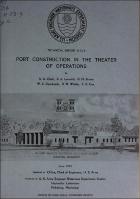Please use this identifier to cite or link to this item:
https://hdl.handle.net/11681/13204| Title: | Port construction in the theater of operations |
| Authors: | Clark, Alton A. Lacavich, Richard J. Brown, D. N. (Donald N.) Dornbusch, William K. Whalin, Robert W. (Robert Warren) Cox, F. B. (Frank B.) |
| Keywords: | Cargo ships Container ships DeLong piers Dredges Marine terminals Marine transportation Military facilities Ports Terrain intelligence Unsurfaced soils Harbors Design Construction |
| Publisher: | Hydraulics Laboratory (U.S.) Engineer Research and Development Center (U.S.) |
| Series/Report no.: | Technical report (U.S. Army Engineer Waterways Experiment Station) ; H-73-9. |
| Description: | Technical Report Abstract: Recent developments in marine shipping will have a profound effect on military port construction. The use of large container vessels and super tankers already requires that commercial marine terminals be extensively modified in order to operate efficiently, and the Army must be capable of constructing facilities that are compatible with the new developments. This report furnishes basic reference information for use in selecting sites for military ports and port facilities, fulfilling the requirements of container facilities, and solving engineering problems that new developments will place on the military engineer. It involves only present state-of-the-art techniques and equipment that permit the off-loading of all types of commercial and military cargo vessels at the earliest practical time after a site has been tactically secured. The effects of new shipping developments and the modifications that they will require in base development plans are described. A comprehensive section is included on the collection of terrain intelligence data that cover topographical, hydrographical, and cultural aspects of the proposed port location and sources and techniques to acquire necessary data for sound engineering decisions. Design considerations for structures are discussed with emphasis placed on container facilities. One of the critical design factors is the type of equipment that will use the facility. An evaluation was performed of the Army's existing DeLong barges to determine if they could be efficiently utilized as container facilities, and, if so, to determine the engineering problems that would develop. The design considerations and problems involved in the selection of fenders are also discussed herein. Flexible pavement curves, M8A1 landing mat requirements, and vehicle cone indexes for sample container handling equipment operating on unsurfaced soils are developed herein. The criteria for operation of aircraft on unsurfaced areas were used for medium- and high-strength soils, and the criteria for the design of military roads and airfields were employed in the analysis of M8A1 landing mat and flexible pavements. Surface area requirements for container facilities are also discussed. The capabilities and uses of different types of dredges and new developments in transportability to the theater of operations are also discussed. Cranes, pile driving equipment, and construction barges are discussed regarding their use in constructing port facilities. Results of the study indicate that recent developments in marine shipping will significantly change the requirements for port facilities within the theater of operations. NOTE: This file is large. Allow your browser several minutes to download the file. |
| Rights: | Approved for public release; distribution is unlimited. |
| URI: | http://hdl.handle.net/11681/13204 |
| Appears in Collections: | Technical Report |
Files in This Item:
| File | Description | Size | Format | |
|---|---|---|---|---|
| TR-H-73-9.pdf | 29.44 MB | Adobe PDF |  View/Open |